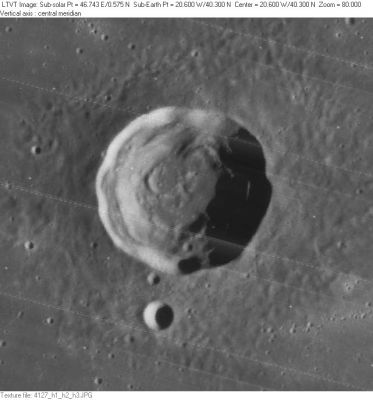Le Verrier
Contents
Le Verrier
(current IAU name; former IAU name: Leverrier)
|
Lat: 40.3°N, Long: 20.6°W, Diam: 20 km, Depth: 2.1 km, Rükl 11 | |
Right: François Emond; Helicon (left) & Le Verrier (right)
Images
LPOD Photo Gallery Lunar Orbiter Images Apollo Images
- The distinct couple Le Verrier and Helicon was also captured on several of Apollo 15's orbital Fairchild photographs (Revolution 35). AS15-M-1552 is one of those photographs. Le Verrier and Helicon are noticeable near the central part of the curved horizon (the "right" part on the LPI's online version) (looking north -- take a look at the HIGH RESOLUTION version: the Print Resolution JPG, 3.1 MB). - DannyCaes Dec 18, 2007
Maps
(LAC zone 24B4) LAC map Geologic map
Description
Description: Elger
(IAU Directions) LEVERRIER.--The more easterly of a pair of little ring-plains on the N. side of the Mare Imbrium, and S.E. of The Laplace Promontory. It is about 10 miles in diameter, with walls rising some 1,500 feet above the Mare, and more than 6,000 feet above the interior, which seems to be without a central mountain or other features. Schmidt shows the crater on the N. rim and another on the S.W. slope, both of which are omitted by Neison, though they are easy objects when Helicon is on the morning terminator. About 20 miles on the S.W. there is a very bright little crater on a faint light area.
Description: Wikipedia
Additional Information
- Depth data from Kurt Fisher database
Viscardy, 1985: 2.1 km - TSI = 25, CPI = 5, FI = 20; MI =50 Smith and Sanchez, 1973
- Is Le Verrier the brightest one of the pair Helicon/ Le Verrier when both of them are observed during Full Moon? According to Dennett and Gaudibert Le Verrier is the brightest one. See footnotes on page 125 of T.W.Webb's Celestial Objects for Common Telescopes, Volume 1; chapter THE MOON). - DannyCaes Jun 21, 2015
Nomenclature
- Named for Urbain Jean Joseph Le Verrier (March 11, 1811 – September 23, 1877), a French astronomer and mathematician who specialized in celestial mechanics, best known for his part in the discovery of Neptune using only mathematics and astronomical observations of the known planet Uranus.
- According to Mary Blagg's Collated List (1913), this crater was called Helicon A by Beer and Mädler, Helicon West (as opposed to Helicon East, for the modern Helicon) by Schmidt, and Leverrier by Neison. Whitaker (p. 150) notes that the name Leverrier seems to have been introduced on an "otherwise unremarkable" lunar map published by Lecouturier and Chapuis. - JimMosher
- The name Leverrier was selected as catalog entry 1304 for the original IAU nomenclature of Named Lunar Formations (1935).
- The spelling was changed to Le Verrier in IAU Transactions XIB (1961).
- On the odd looking moonmap made by Johann Hewelcke (1647), the couple of craters Helicon and Le Verrier seem to have been one and the same formation called Insula Erroris (a ring of small mountains).
LPOD Articles
Bibliography
Le Verrier in the Sourcebook Project (William R. Corliss); the intramercurial planet
There's much information about Le Verrier's involvement in the search for (and observations of) the so-called intramercurial planet (Vulcan) in the book Mysterious Universe, a handbook of astronomical anomalies (W.R.Corliss, 1979).
